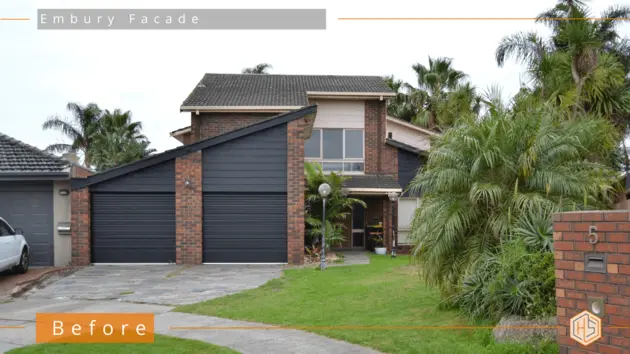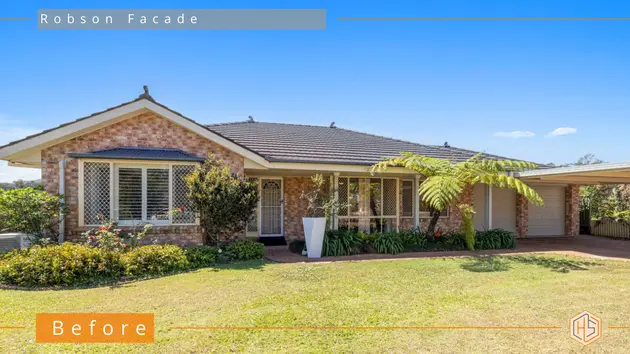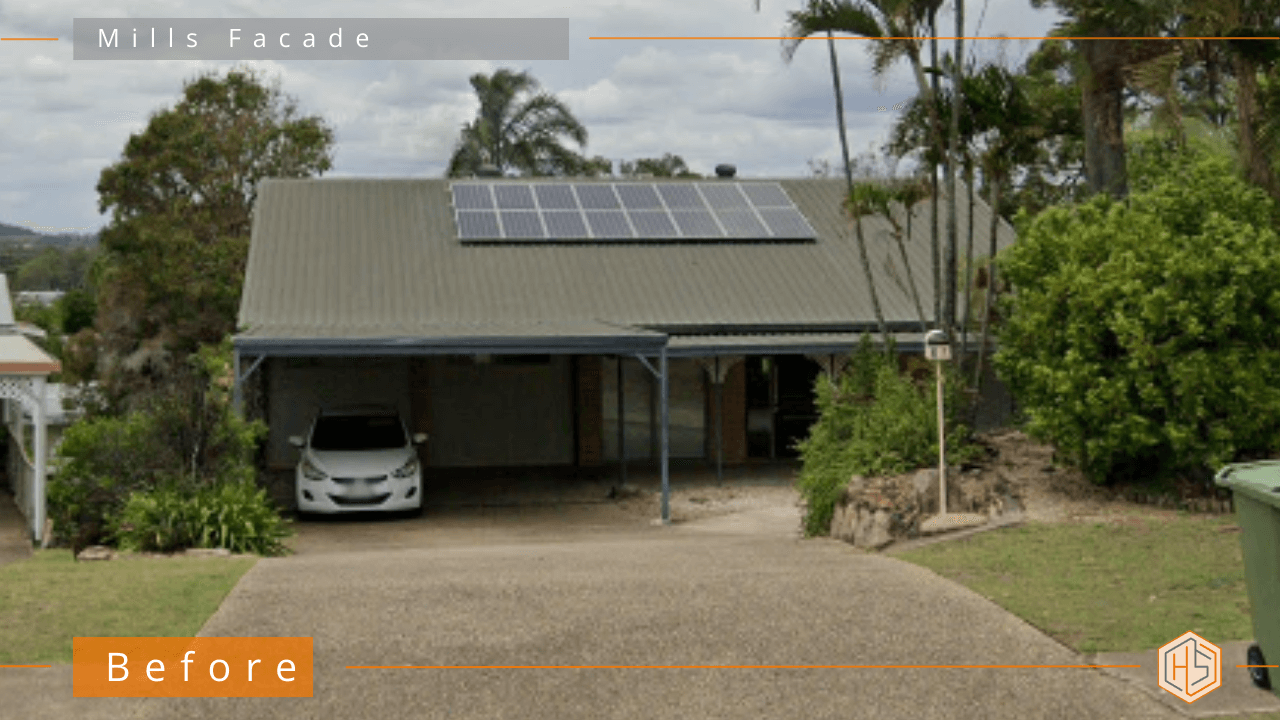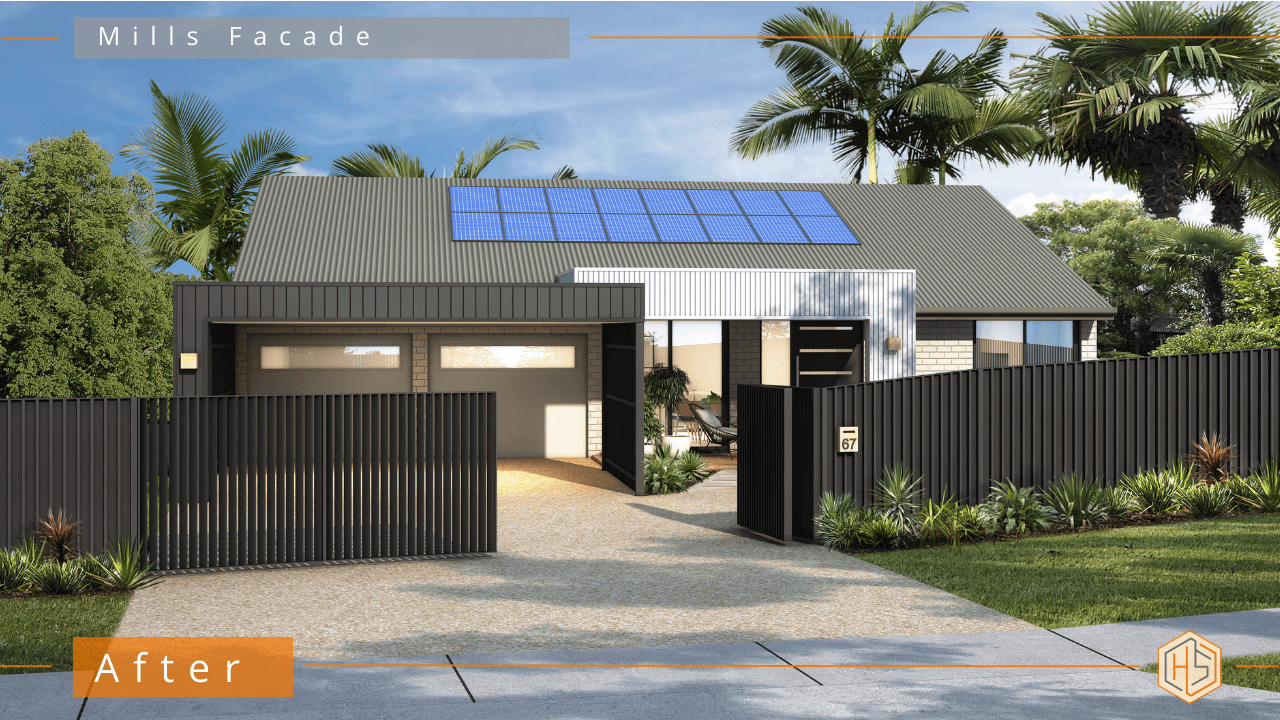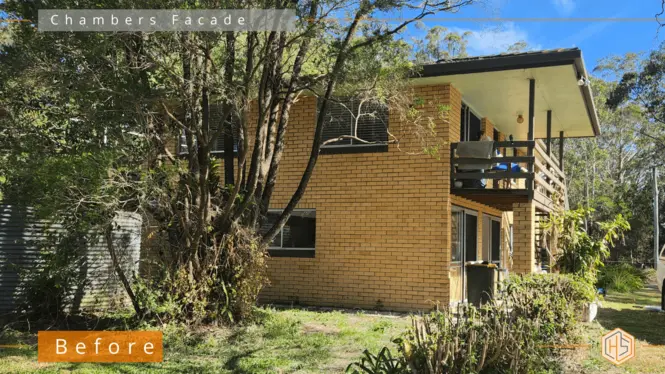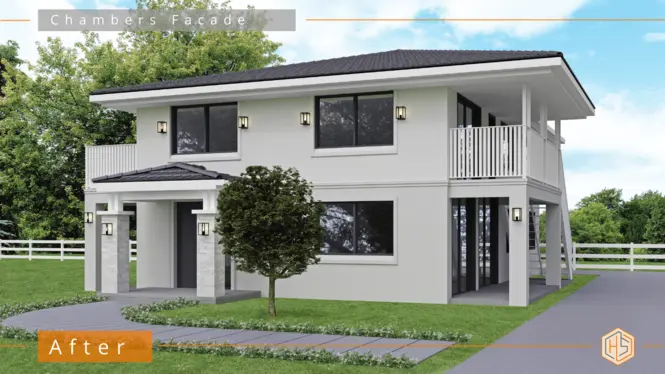
Renovating a brick house can often feel like a daunting challenge, especially when the first recommendation you hear is to render the exterior for a modern finish. While rendering can be a great option for achieving a smooth, contemporary look, it’s not always necessary to transform your home into the stunning showpiece you envision. In fact, preserving the unique charm of brick and incorporating some clever design elements can give your home a fresh, modern aesthetic—without losing its character or breaking the bank. Here’s how to take a dated brick facade and elevate it with style:
Embrace Brick’s Natural Texture – One of the primary reasons people lean towards rendering when renovating a brick house is to conceal the sheer quantity and ‘brown-ness’. But with a bit of creativity, these perceived imperfections can be turned to their advantage.
I love to incorporate cladding materials that complement the existing brickwork. It’s a great way to reduce a sea of brown texture and introduce more modern colours and patterns into the mix. Horizontal timber cladding, metal elements, or even contemporary panels like James Hardie’s Axon Board can add dimension and interest to the exterior. Strategically placing these materials—such as on part of an upper story, around the entrance, or as an accent wall—can create contrast and modernity without covering the entire house.
👇Designed by Hotspace👇
Update Windows & Entryways – Modernising the window frames, doors, and even the front entrance can dramatically change the look when renovating a brick house. Opt for slimline, black or charcoal window frames and a statement front door with a pop of colour or a unique design to draw attention. Consider installing larger windows or stacking doors to give the facade a more open and inviting feel. Adding a new portico or extending the roofline forward can also enhance the front entrance, giving it a grander presence.
Landscaping & Lighting – Don’t overlook the importance of landscaping and lighting in your facade’s transformation. Clean, minimal landscaping with modern planter boxes, feature trees, and structured garden beds complement the clean lines of a modern aesthetic. Layered exterior lighting, from ground lights to wall sconces, can highlight the textural differences between the brick and any new materials, showcasing the house’s best features.
Rendering a brick house isn’t the only path to achieving a modern transformation. With strategic paint choices, clever use of cladding, and thoughtful updates to windows, doors, and landscaping, your brick home can be completely re-imagined—maintaining its authenticity while stepping into the present.
Renovating a brick house, but need help to achieve a striking design? Send me some photos and tell me a bit about your project here… (https://hotspaceconsultants.com/preliminary-enquiry/).
Jane
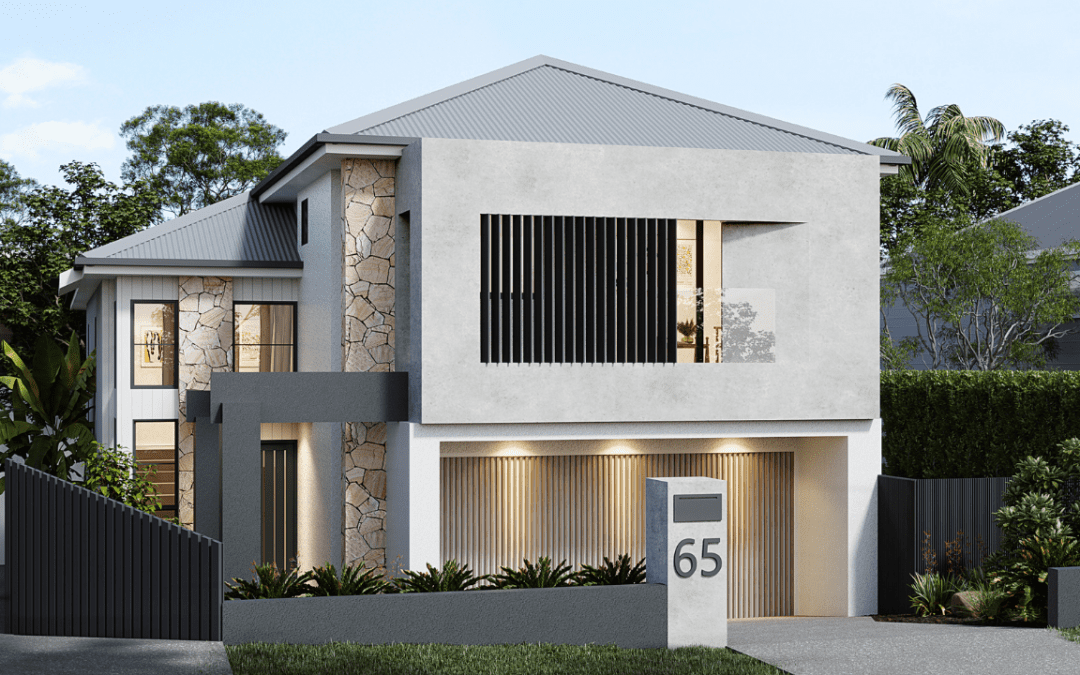
Choosing the right exterior colours can make or break your home’s street appeal. The right palette can highlight architectural features, create harmony with the surrounding environment, and give your home a unique personality. However, it’s easy to get overwhelmed by the endless colour options and make decisions that detract from the overall look rather than enhance it. To help you avoid these pitfalls, let’s explore some of the most common mistakes homeowners make when choosing exterior colours—and how to get it right.
Using Too Many Colours – Less is often more when it comes to choosing exterior colours. Homeowners sometimes get carried away and add multiple colours for trims, windows, and doors, hoping to create contrast and interest. However, using too many colours can make the facade look chaotic and over-complicated. Stick to a maximum of four colours: a dominant colour for the main body, and 2-3 secondary colours for trims, accents and feature elements. This approach maintains simplicity and balance while still providing enough variety to highlight architectural features.
👇Designed by Hotspace👇
Overlooking Undertones – Every colour has an undertone that can influence how it pairs with other colours. For instance, a grey with blue undertones can look cold and stark next to warm-toned brickwork or timber cladding. This mismatch can result in a facade that feels unbalanced. When selecting exterior colours, pay attention to undertones and test them against each other. This will help ensure that all colours within your palette work harmoniously.
Choosing Colours in Isolation – Another common error is selecting colours without considering the fixed elements of the house, such as the roof, driveway, and any existing stone or brickwork. These elements already have a dominant colour or tone that should inform your exterior palette. Ignoring them can lead to a disjointed look that feels mismatched and unplanned. For a cohesive finish, choose colours that complement these features rather than compete with them.
Ignoring Lighting and its Impact – One of the biggest mistakes homeowners make is not considering how natural lighting affects exterior colours. Colours can appear significantly different depending on the time of day and weather conditions. For example, a colour that looks perfect in the morning light may appear too washed out in the harsh midday sun or too dark in the evening. Before committing to a colour, always test swatches on the exterior and observe them at various times throughout the day. This step will ensure that the final colour remains consistent with your vision regardless of lighting.
Choosing Colours Based Solely on Trends – Trends come and go, and what’s in vogue today may look dated in just a few years. Choosing exterior colours based solely on current trends can lead to regret down the road. Instead, focus on timeless colours that reflect the architectural style of your home and suit your personal tastes. You can always incorporate trends in smaller, easy-to-change elements like door colours or garden features, but keep the primary exterior colours classic for longevity.
Not Considering the Neighbourhood Context – Your home doesn’t exist in isolation; it’s part of a broader streetscape. While it’s important to choose colours that reflect your style, going too bold or drastically different from neighbouring homes can make your house stick out for the wrong reasons. Instead, look at the colour palettes used in your neighbourhood and aim to complement them. A coordinated approach will add to the overall appeal of the street and ensure your home stands out in a positive way.
Forgetting to Sample Properly – Finally, not sampling colours properly is a mistake that can lead to major disappointment. Small paint chips or digital renderings don’t provide an accurate representation of how the colour will look on your home. Invest in sample pots, paint large swatches on different parts of your house, and observe them at different times of the day. This will give you a true sense of the colour’s impact on a larger scale.
Choosing the right exterior colours is a blend of art and strategy. By avoiding these common mistakes, you can ensure your home’s facade is beautiful, cohesive, and timeless. Take the time to test, plan, and evaluate your choices, and you’ll be rewarded with a stunning home exterior that you’ll love for years to come.
Jane
https://hotspaceconsultants.com/preliminary-enquiry/
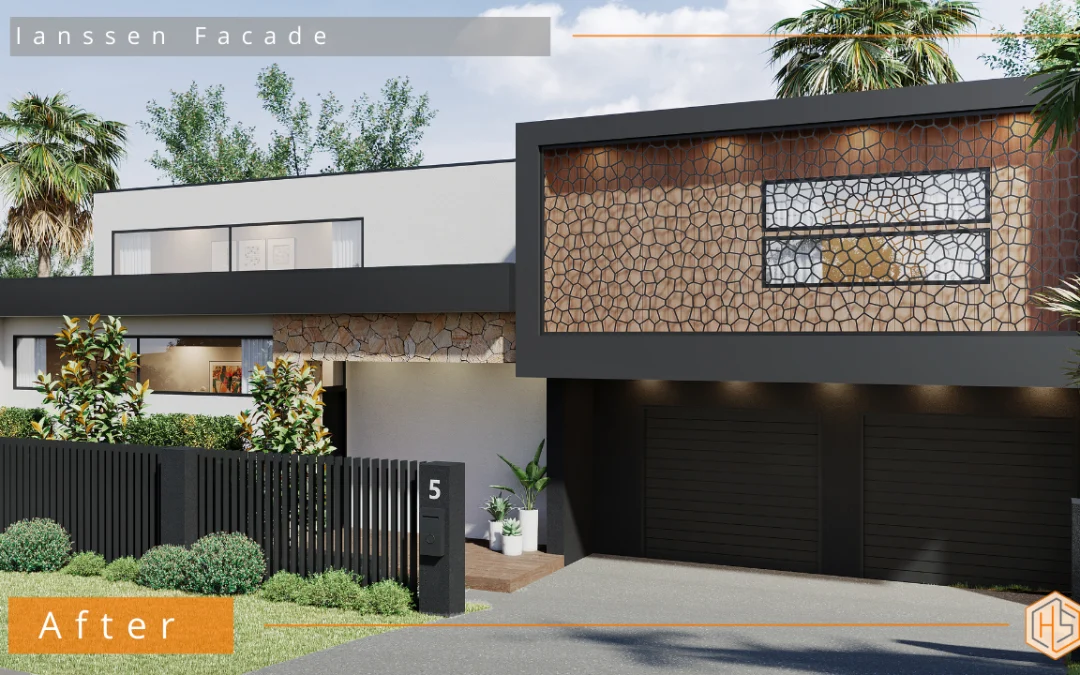
Feature walls have a bit of a reputation, don’t they? Some people love them, while others —maybe you — have been hesitant to embrace the idea. You’ve probably seen too many poorly executed feature walls that just overwhelm a space, leaving you wondering why they even exist in the first place.
But here’s the thing: if done right, a feature wall can elevate your home’s design and create a focal point that feels balanced, stylish, and full of personality.
This façade transformation I recently designed shows exactly how powerful a well-planned feature wall can be. The house went from flat and forgettable to bold yet elegant. If you’ve ever thought, “I’d never do a feature wall,” you might want to think again—because with the right approach, it can look absolutely incredible.
Let’s break down what makes a great feature wall and how you can get it right the first time.
Start with Statement Colours that Complement – The first thing to consider when creating a feature wall are the colours. You want them to stand out, but not too much. Think of it as a statement piece that enhances your overall design, not competes with it.
For this Central Coast NSW renovation, I selected a deep, earthy tone for the feature wall surround, which beautifully contrasts with the clean, neutral palette of the rest of the home. The colour enhances the surrounding textures without overpowering them. When you’re choosing a colour, opt for something bold yet complementary to the rest of your home. Darker tones like deep charcoal can be sophisticated and striking, especially when paired with lighter, neutral surroundings.
👇Designed by Hotspace👇
Texture: Add Depth and Interest – Plain painted walls are fine, but if you really want to elevate your home, consider adding texture to your feature wall. Whether it’s timber, stone, or a unique pattern, texture gives your house dimension and makes it much more visually interesting.
In this case, the feature wall comes alive with a timber-look cladding and honeycomb-style laser-cut overlay. The intricate texture creates a bold yet tasteful statement, adding layers of warmth and character.
Lighting: Let Your Feature Wall Shine – Lighting can make or break your feature wall. The right lighting enhances textures, highlights your chosen colours, and adds warmth to the house façade design. Think about how lighting changes throughout the day—natural light will play off the textures differently as the sun moves, and at night, warm ambient lighting can make the wall glow, creating a cozy, inviting atmosphere.
Restraint: Don’t Overdo It – Here’s the golden rule when it comes to feature walls: less is more. A great feature wall needs space to breathe. If you try to incorporate too many bold elements across the front of your home, your feature wall will lose its impact. Keep the rest of the design simple and let the wall be the hero.
For this exterior design, I kept the surrounding elements to a minimum — clean lines, soft neutrals, and an uncluttered landscape. This allowed the feature wall to stand out without the rest of the home competing for attention.
When planning your own feature wall, remember to let it be the focal point. Balance the space by keeping the rest of the design understated and let the feature wall speak for itself.
Ready to Transform Your Space? If you’ve been on the fence about renovating your home exterior, hopefully this has inspired you. The right features (feature wall or otherwise) can turn a simple home into something truly remarkable.
And the best part is that it’s entirely up to you how bold—or how subtle—you want to go. Just remember, it’s all about balance. Find that, and you’ll have a feature wall that’s not just a trend, but a timeless addition to your home!
Feeling inspired but need help to achieve a striking design for your home? Send me some photos and tell me a bit about your project here… (https://hotspaceconsultants.com/preliminary-enquiry/)
Jane
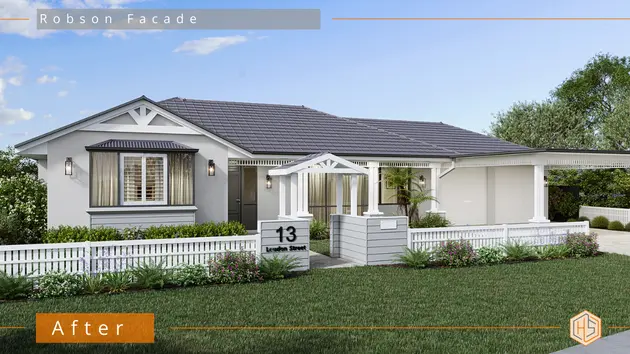
Selecting the right exterior paint colours is one of the most impactful decisions you can make when updating your home. The right colours will elevate your home’s kerb appeal, complement the surrounding environment, and reflect your personal style. However, choosing colours isn’t as simple as picking your favorites. It’s a strategic process that blends aesthetics, architecture, and even a bit of psychology. Whether you’re aiming for a sleek modern look, a timeless classic appeal, or a relaxed coastal vibe, here’s what you need to know to get it right.
Understanding the Psychology of Colour – Colour has the power to influence emotions and perceptions. For example, cool colours like blues and greens tend to evoke a sense of calm and serenity, making them ideal for coastal or natural-inspired designs. Neutral and warm tones, such as whites, greys, and taupes, are versatile and create a sense of stability and sophistication.
When choosing a palette, think about the mood you want to establish. Do you want your home to feel inviting and warm, or modern and understated? Consider not just how the colours make you feel, but how they will be perceived by others—particularly if you’re thinking about resale value.
👇Designed by Hotspace👇
Choosing Colours Based on Architectural Style – Your home’s architectural style is a critical factor when deciding on exterior paint colours. A mid-century modern home, for instance, lends itself to bold, contrasting colours like charcoal grey and crisp white, complemented by pops of vibrant hues. On the other hand, a classic heritage-style home looks stunning with soft, muted tones like sage green, cream, or baby grey/blue, paired with white trims for an elegant finish. For coastal homes, think breezy, light-filled palettes that reflect the surroundings—whites, soft blues, sandy beiges, and driftwood-inspired greys. These colours work harmoniously with the natural elements and provide a relaxed, beachy atmosphere. Understanding your home’s architecture ensures that your chosen colours enhance its character rather than clash with its design.
Harmonizing with the Surroundings – One of the most common mistakes homeowners make is choosing exterior paint colours in isolation without considering the rest of the house. Take note of any elements that will not be changed, and be sure to choose colours that complement these existing features rather than compete with them. A well-balanced colour scheme takes all these factors into account, creating a cohesive and polished look.
Bringing It All Together – Choosing the right exterior paint colours is a blend of science, style, and strategy. Take time to consider the mood you want to create, the architectural style of your home, and the surrounding environment. Test your choices thoroughly and be mindful of undertones, fixed elements, and lighting conditions. With a thoughtful approach, your home’s facade can be transformed into a stunning, cohesive masterpiece that reflects both your personality and the beauty of its surroundings.
If you’ve tried to update your home or simply have no idea where to begin, send me a message via the link below.
Jane
https://hotspaceconsultants.com/preliminary-enquiry/
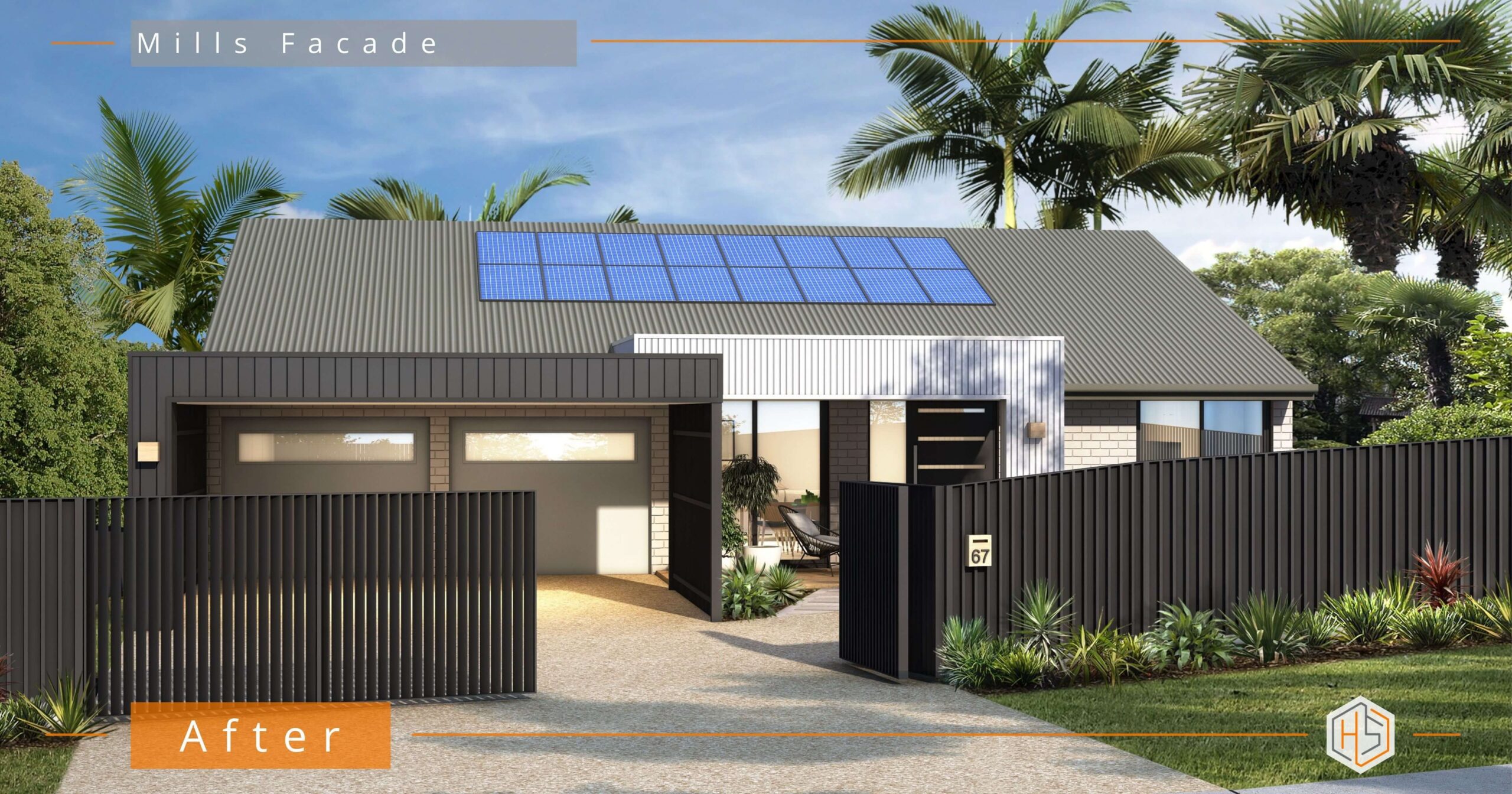
Who knew you could use Optical illusions to make your home appear differently (better) than the reality!?
In the same way Fashion Designers make their subjects appear taller, shorter, wider, narrower, more elegant or more masculine, we can use optical illusions on our Facade renovation to give our home more presence.
Here are a few of the techniques I use when designing or redesigning my client’s Facades;
1. Making your House appear Taller –
Vertical cladding: Using vertical style cladding on part or all of the exterior of your home will instantly create an illusion of height. Your eye is drawn upwards, making the house appear taller than it actually is.
Pillars or columns: Adding pillars or columns near the entrance will give the illusion of increased height to the overall structure.
Slim, tall windows: If you’re able to change the windows, opting for a taller/elongated shape will help to accentuate the height of the walls.
👇Designed by Hotspace👇
2. Making your House appear Wider –
Horizontal cladding or detailing: Using horizontal accents or cladding styles will help make your home seem wider
Accent colours on the horizontal: Using contrasting/accent colours or materials in horizontal format will visually lengthen the area. This could be a contrasting balustrade handrail for example, or a horizontal arch feature.
Remove as many vertical accents as possible: For example fences or landscaping that chop the house in two. Or any obvious vertical contrasting colours.
3. Making your House appear More Spacious –
Light colour palette: Opt for light-coloured exteriors as they reflect more light, making the house feel more open and spacious.
Large windows and glass doors: Install large windows and glass doors to allow a seamless connection between the interior and exterior, giving an illusion of a more extensive living area.
Remember, it’s not about deceiving the eye but about artfully crafting an illusion to enhance your home’s best features and downplay its less favourable ones!
If you’ve tried to update your home or simply have no idea where to begin, send me a message via the methods below. Please include a photo of your home, email address and phone number.
Jane
https://hotspaceconsultants.com/preliminary-enquiry/
Home renovations aren’t just about sprucing up how your house looks; they’re your secret weapon to skyrocketing your property’s value.
Strategic renovations aren’t merely about enhancing your living experience and ‘making your money back’; they’re about shrewd financial planning. The below transformation of a $1M property into a $1.4M gem (estimated reval), with a thoughtful investment of $150k including some DIY ($100k on exterior and front yard), perfectly illustrates this concept.
By choosing the right materials and colours for the most impactful components of your home, your exterior design ideas can add significant value and make it look stunning at the same time.
I’m not talking about a dollar-for-dollar improvement. I’m talking about profiting from every single dollar you spend (eg investing $150k and making a profit of $250k in the below scenario) and the benefits are immense;
👇Designed by Hotspace👇
Lower Loan-to-Value Ratio (LVR): When your home’s value increases, its LVR drops. This is the mortgage amount as a percentage of the appraised property value. A lower LVR can offer more attractive mortgage rates, easier refinancing, and increased financial flexibility.
Higher Equity: An increase in property value directly bolsters your home equity. This can be leveraged for additional investments or as an emergency fund.
Greater Return on Investment (ROI): In this case, a $150k investment in renovations led to a $400k increase in home value, indicating a return significantly beyond the original outlay.
Market Advantage: A visually appealing and high-value home stands out in the real estate market, potentially attracting higher rental rates or being more appealing to buyers if you decide to sell.
While a DIY approach to renovations might be tempting, harnessing the insights of an experienced professional’s exterior design ideas is invaluable. Their advice on material selection, design direction, and strategic planning helps your investment work smarter, not harder. Their expertise will allow your home to exude the luxury of a million-dollar property (or, as in this case, a 1.4 million-dollar one!).
Transforming your home isn’t just about refurbishing your living environment; it’s a powerful strategy to enhance your financial prosperity.
If you’re ready to add value to your home with a beautiful renovation, get in touch with me at https://hotspaceconsultants.com/preliminary-enquiry/
Jane


